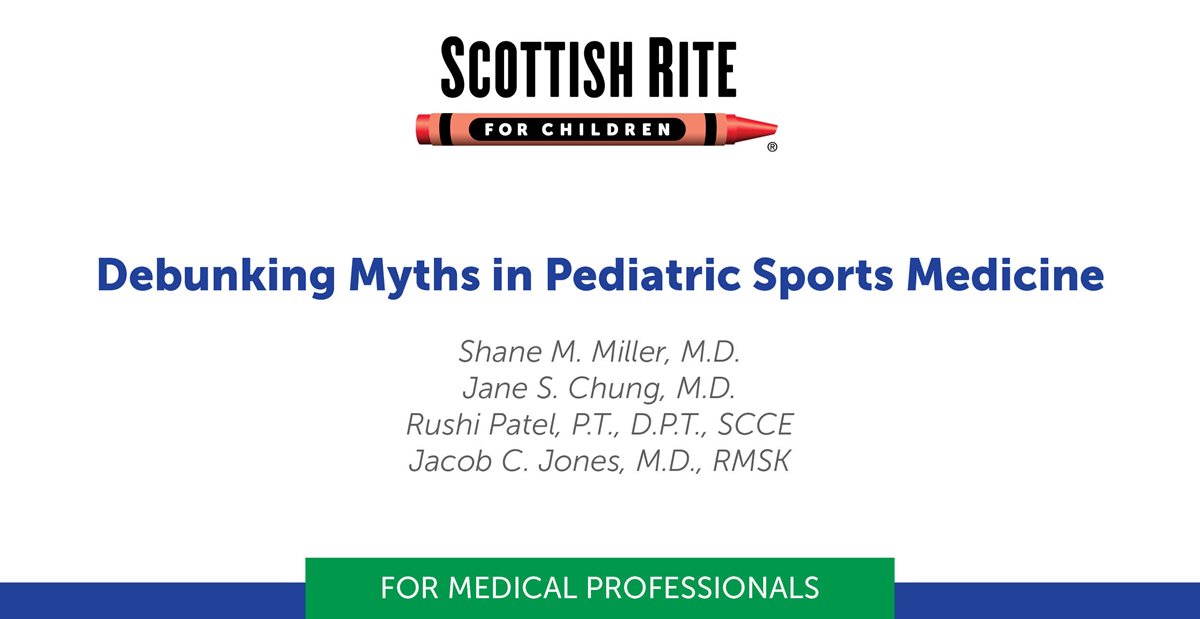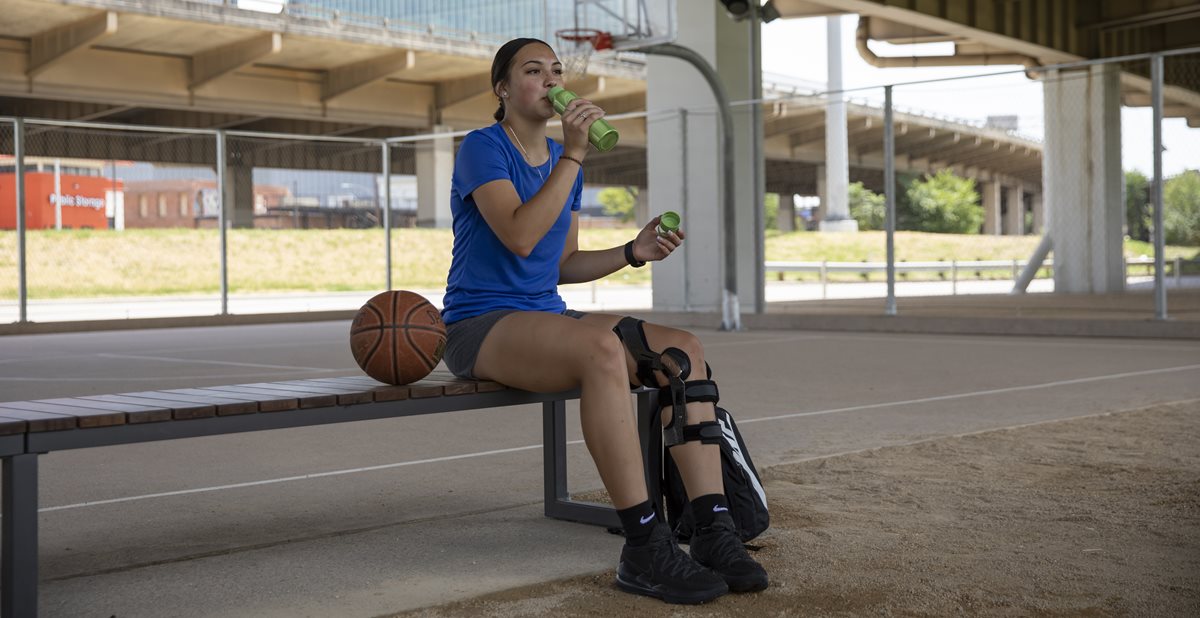
Jan 25, 2022 / Sports Medicine
Debunking Myths in Pediatric Sports Medicine
Our Sports Medicine team has tackled a few pediatric sports medicine trends in an education series for Medical Professionals that is packed with evidence-based information. You can watch the full lecture, portions of the lecture or read this quick summary to learn more about the key messages.
Download the PDF.
Watch the lecture now.
Strength Training – Shane M. Miller, M.D.
Youth sports and performance are booming industries, especially here in Frisco, where our sports medicine team is based. Pediatric sports medicine physician Shane M. Miller, M.D., knows that young athletes are constantly looking for an edge, and he addressed a few misconceptions in this lecture.
Will strength training stunt your growth?
Miller says no, but he emphasizes that properly designed and supervised programs are key. Poor form, overuse and excessive resistance may cause injuries that could affect growth plates, especially if they go untreated. An appropriate amount of stress on the bones likely has a positive effect on bone mineral density and bone development.
Is strength training safe for kids?
Yes, with proper supervision and an emphasis on proper technique. Before puberty, strength gains are noted in muscle neuron activity. Hypertrophy won’t occur until hormones, particularly androgens, are present.
Young kids do not need resistance from weights or bands to begin strength training. Some classic moves take advantage of their body weight to increase muscle strength and coordination. Frog Jumps and Spider-Man crawls are a few examples.
Read more about building lean body mass in young athletes in this article.
Cryotherapy – Jane S. Chung, M.D.
Cryotherapy is a term that describes the use of cold to treat symptoms of illness or injury. This has been used for thousands of years and includes cold applied to one area or the whole body. Pediatric sports medicine physician Jane S. Chung, M.D., says she recommends the use of cold therapy to many of her patients, particularly in the acute phase of injury or symptom exacerbation.
Minimal side effects and several treatment effects of cryotherapy make this an appealing approach to treating swelling and pain.
- Pain relief – Cold temperatures slow down nerve conduction, reducing pain in that area.
- Vascular response – A chain of events reduces blood flow, swelling and bruising in the area that is cooled.
- Hypometabolism – Cooling slows metabolic enzymatic activity that leads to a decreased inflammatory response.
Cold therapy is typically used in the acute inflammatory phase during the first 48 to 72 hours after an injury or trauma. However, it may also be used in the repair (up to six weeks) or remodeling (up to 12 months) phases of recovery.
Our physical therapists use a system that offers a combination of cold and compression using a joint-specific splint postoperatively. Proper timing and the use of a protective layer on the skin are important components of educating patients to avoid possible frostbite and nerve palsy complications from excessive cold therapy. Contraindications include:
- Use prior to vigorous physical activity or exercise because it may affect muscle flexibility and lead to injuries.
- Patients who have cold sensitivities, such as those with Raynaud’s or cryoglobulinemia.
Whole-body cryotherapy (WBC) has become very popular among professional athletes for injury treatment and proposed enhanced recovery. Though an out-of-pocket expense, it has become reasonably available to the public in North Texas, but it is important to know cryotherapy is not FDA regulated.
Reviewing the literature, Chung found limited studies addressing the claim regarding its effects on increased recovery rates and decreased inflammation in the adult population. More studies that have larger sample sizes and use controls in the study design are needed to further assess the use of WBC, especially in young athletes. There are currently no studies of WBC done in young athletes. WBC is currently not recommended for young athletes due to lack of studies and safety.
Therapeutic Taping – Rushi Patel, P.T., D.P.T., SCCE
Sports physical therapist Rushi Patel, P.T., D.P.T., SCCE, discussed the available evidence on therapeutic taping. Many kinds of tape on the market claim to provide stability, facilitate muscles (or make muscle movement easier), reduce swelling, speed up recovery and improve performance. Many collectively refer to the products by one brand name, Kinesio® tape, but there are numerous manufacturers offering one or more options. The products range not only in color but also in material, tension and adhesive qualities.
Patel provided a perspective from his professional experience and reviewed the latest available evidence. Here are his take-home points:
- Some rigid tapes MIGHT:
- have short-term effects for providing ankle stability.
- Therapeutic taping does not:
- facilitate muscles.
- improve proprioception (awareness of the position and movement of the body) or alter shoulder pain.
- improve symptoms of low back pain.
- speed up recovery or healing.
Though he encourages individuals to stick with things that work for them, this is not the first line of defense he recommends for instability in ankles, muscle weaknesses or other musculoskeletal complaints or performance shortcomings. Also, contrary to popular belief, current evidence does not support one method or direction of taping compared to another. Taping method or technique can simply be based on individual preference, access, and comfort during activity. Therefore, therapeutic taping may be an effective short-term tool as a component within a comprehensive rehabilitation or training program.
Stem Cell Therapy – Jacob C. Jones, M.D., RMSK
Stem cell therapy refers to using stem cells to treat or improve a condition. Pediatric sports medicine physician Jacob C. Jones, M.D., RMSK, describes the stem cells as “transformers” because they can differentiate or almost transform into another cell. This has led some to claim that they are the “silver bullet” or “holy grail” of orthopedics and could show enormous potential.
This therapy requires multiple complicated steps from the collection to the processing and to its usage. Studies are fairly limited at this point, and all have been completed in adult populations. Therefore, safety, efficacy and outcomes are unclear in the pediatric and adolescent population, so this is not FDA approved for pediatrics. Additionally, due to the lengthy process and the very small amount of stem cells within select tissues, this treatment is currently very expensive.
“For these reasons, we do not recommend stem cell treatments for any pediatric sport-related conditions,” Jones says.
Wrap-Up
In an engaging wrap-up of this program, the panel addressed their tendencies to apply these treatment techniques in their practice as pediatric sports medicine specialists.
Learn more about our sports medicine program.



